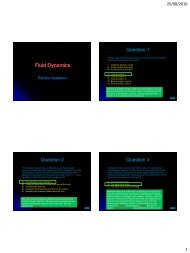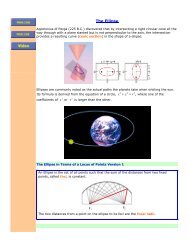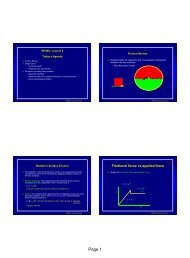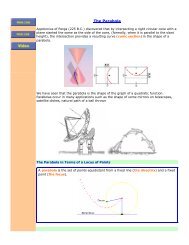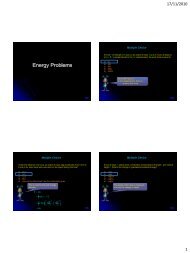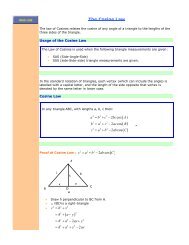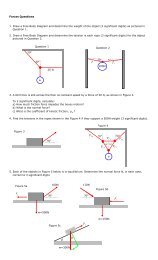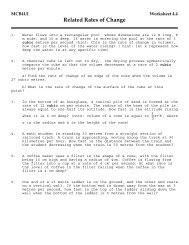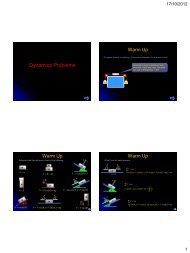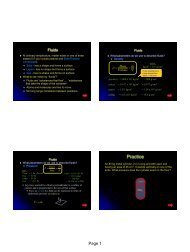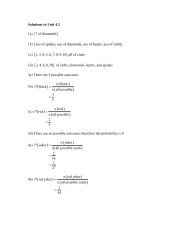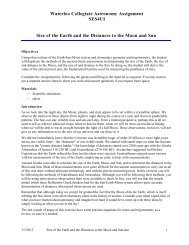Atomic Absorption and Emission Spectra - The Burns Home Page
Atomic Absorption and Emission Spectra - The Burns Home Page
Atomic Absorption and Emission Spectra - The Burns Home Page
Create successful ePaper yourself
Turn your PDF publications into a flip-book with our unique Google optimized e-Paper software.
Physics Tool box12.4 <strong>Atomic</strong> <strong>Absorption</strong> <strong>and</strong> <strong>Emission</strong> <strong>Spectra</strong>‣ A continuous spectrum given off by a heated solid is caused by theinteractions between neighbouring atoms or molecules. An emissionspectrum or line spectrum is emitted from electrically “excited” gases.‣ An absorption spectrum occurs when some of the light from a continuousspectrum is absorbed upon passing through a gas. Atoms absorb light of thesame frequencies that they emit.‣ An atom is normally in its ground state. <strong>The</strong> excited states or energy levelsare given by the discrete amounts of energy that atom can internally absorb.‣ Ionization energy is the maximum energy that can be absorbed internally byan atom, without triggering the loss of an electron.‣ In the emission spectrum, the energy of the emitted photon equals thechange in the internal energy level: Ep E h El.‣ When a photon is absorbed, its energy is equal to the difference between theinternal energy levels: Ep E h El.‣ Atoms can receive energy two ways: by collisions with high speed particles,such as electrons, <strong>and</strong> by absorbing a photon.‣ Once raided to an excited state, an atom can emit photons either throughspontaneous emission or through stimulated emission.It has been long known that matter, when heated, gives off light. Solids, liquids, <strong>and</strong>very dense gases gave off light with a continuous spectrum of wavelengths. But whenheated (in the form of a high voltage) was given to a rarefied gas, the light spectrumwas quite different.It was discovered that the heated solid emitted a continuous spectrum from theinteractions between each atom or molecule <strong>and</strong> its closest neighbour. Whereas, in ahot, rarefied gas, the atoms are far enough apart to ensure that any light emittedcomes from the individual, isolated atoms.As early as the beginning of the nineteenth century, it was known that the radiationfrom electrically “excited” gases was discrete rather than continuous. That is, an excitedgas only gives off specific frequencies of light. When this light is passed through aspectroscope, a bright-line emission spectrum is observed.Each gas emits its own specific set of characteristic frequencies (like a fingerprint),called its emission spectrum. By matching this spectrum to the elements, we have avery accurate method for identifying elements.It was also shown that when white light is allowed to pass through a gas, <strong>and</strong> the
spectrum of the transmitted light is analyzed with a spectroscope, dark lines of missinglight are absorbed in the continuous spectrum at exactly the same frequencies as thelight in the corresponding emission spectrum. This is the absorption spectrum of theelement as light is absorbed by the element.James Frank <strong>and</strong> Gustav Hertz (In 1914) performed an experiment with Mercury <strong>and</strong>discovered the underlying principle of the emission (<strong>and</strong> absorption) spectrum.<strong>The</strong>y discovered that a mercury atom that has not absorbed any extra internal energyas a result of a collision with an electron is normally found in its ground state. When ithas absorbed 4.9 eV, the smallest amount of energy it is capable of absorbing, its firstexcitation energy, we say that the atom is in its first excited state. Greater amounts ofinternal energy are the second, third <strong>and</strong> so on excitation energies. <strong>The</strong>re are manyexciting levels. It was discovered that above the ionization level, the electrons are nolonger bound to the nucleus of the atom.This ionization energy (the energy required to liberate an electron from an atom) formercury demonstrates that when mercury absorbs energy 10.4eV or greater, thestructure of the mercury atom changes itself. 10.4 eV of internal energy is too great tobe absorbed without the ejection of an electron (leaving a positive ground-statemercury ion behind). <strong>The</strong> ejected electron will carry away any excess kinetic energy notneeded for its release, thus allowing the atom to absorb more energy that 10.4 eV
ExampleElectrons with kinetic energy 13.0 eV collide with atoms of a unknown gas. After thecollision the electrons are found to emerge with an energy of 5.0 eV <strong>and</strong> 8.0 eV. Whatare the first <strong>and</strong> second excitation levels of the gas.Solution:E E En k , initial k , finalE 13.0eV 9.0eV 4.0eV1E 13.0eV 5.0eV 8.0eV2<strong>The</strong> smaller value is the first excitation energy since this is the smallest amount ofenergy an atom is capable of absorbing.In analysing their data, it was discovered that in general, for the emission spectrum ofany element, we can write:E E Ep i fWherelevel, <strong>and</strong>Epis the energy of the emitted photon, Eiis the energy of the higher energyEfis the energy of the lower energy level.In terms of the wavelength of the spectral linehcE EifExampleAn unknown substance has first <strong>and</strong> second excitation levels of 3.45 eV <strong>and</strong> 6.12 eV,respectively. Determine the energy <strong>and</strong> wavelength of each photon found in itsemission spectrum when the atoms are bombarded with electrons of kinetic enegy:a) 3.2 eVb) 5.0 eVb) 7.0 eVSolution:a)Since the first excitation energy is 3.45 eV, no energy is absorbed, <strong>and</strong> thus there is noemission spectrum.b)Since the incident electrons have energies above both only the first excitation level,then only the upward transition to the first excitation level are possible.
E E Ep i f3.45eV0eV3.45eVNow for the wavelengthWe need our Energy in JouleshcEc)p6.6310 J s3.00 10195.5210J73.6010m34 8 J 3.45eV1.6010 5.5210 eV m s19 19With incident electrons of energy 7.0 eV, excitation to both first <strong>and</strong> second energylevels are possible.Thus the same fist values as in part b) along withJE E Ep i f6.12eV0eV6.12eV<strong>and</strong>E E Ep i f6.12eV3.45eV2.67eV<strong>The</strong> wavelengths would then respectively be:hcEp34 8 m 6.6310 J s3.00 10s 19J 6.12eV1.60 10eV72.0310mAnd
hcEp34 8 m 6.6310 J s3.00 10s 19J2.67eV1.60 10 eV74.6610m




